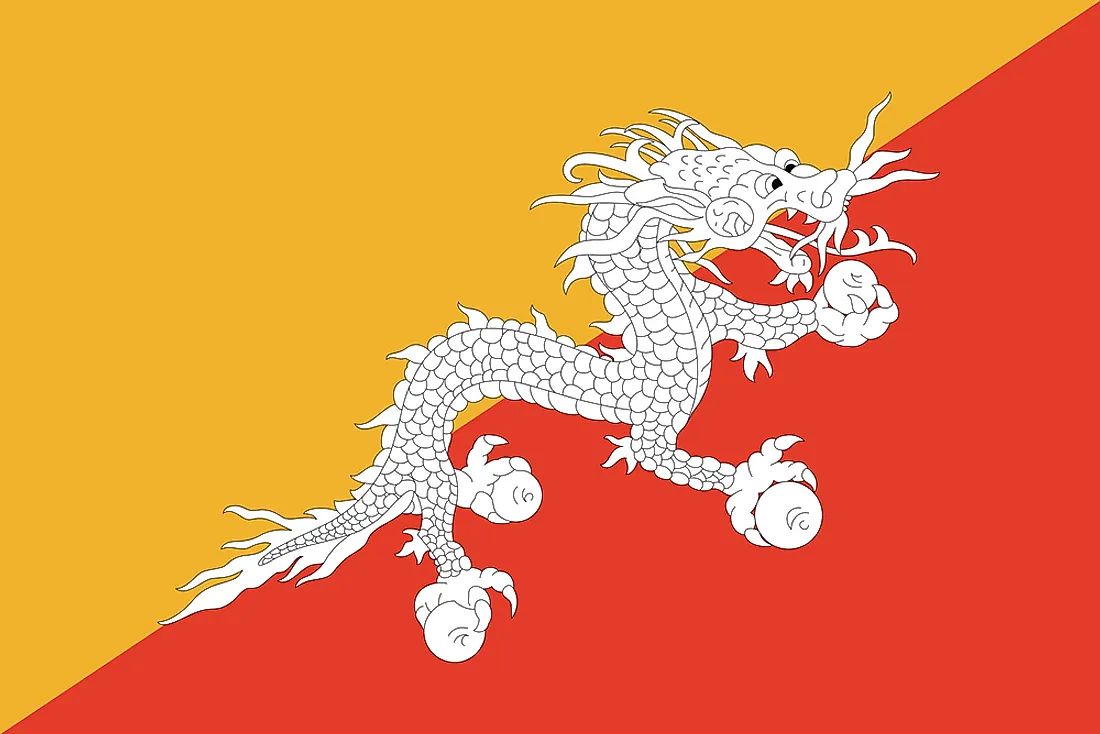What Does The Flag Of Bhutan Look Like?

Featuring the Druk, which is the Thunder Dragon of Bhutanese and Tibetan mythology, Bhutan’s national flag is among the country’s national symbols. The Bhutanese flag was designed in 1947 by Mayum Choying Wangmo Dorji. During the signing of the Indo-Bhutan Treaty, in 1949, a version of the Bhutanese flag was displayed. In 1956, another version was introduced for the purpose of Druk Gyalpo Jigme Dorji Wangchuk’s visit to the eastern region of the country. The second version of the flag was based on pictures of the previous flag; it comprised of a white Druk instead of the original one which was green.
Eventually, the Bhutanese flag was redesigned to have the exact measurements as India’s flag which the people of Bhutan believed and flatter as better than India’s. The flag also went through a series of modifications including changing the color of the background from orange to red resulting to the current design which has been in use from 1969. Bhutan’s National Assembly tabulated and formalized the design of the flag in 1972 and also to set up protocol concerning the conditions for flying the flag and acceptable flag sizes.
Historical Background
Historically, the nation of Bhutan is known to have many names. However, locals call their country Druk in honor of the Bhutanese thunder dragon. It is a tradition dating back to 1189 after Tsangpa Gyare Yeshe Dorje claimed to have witnessed a glowing light and rainbow in the Namgyiphu valley while he was in Phoankar. According to a popular Bhutanese belief, Dorje had gone into the valley to select a site where a monastery would be constructed. It is here that, Dorje heard three peals of thunder which was the description of the sound produced by the dragon. In that same year, the monastery was constructed and named Druk Sewa Jangchubling, as Tsangpa Gyare’s teaching school was named Druk. Eventually, the Druk School was divided into three different lineages. Drukpa was one of the three lineages, it was established by Gyare’s spiritual heir and nephew known as Onrey Dharma Sengye; his lineage would later spread to the entire country. Another theory as to how the dragon ended up on the Bhutanese flag is that it had previously emerged from their neighboring country China. The rulers of Bhutan saw it fit to adopt it in the early 20th century as a symbol of royalty.
Design Of The National Flag Of Bhutan
The country’s current flag is diagonally divided from the lower hoist-side corner. While the top side of the triangle is yellow, the bottom one is red. A huge black and white dragon is centered along the dividing line facing the opposite side of the hoist. The dragon holds a jewel or Norbu in all four claws. The flag’s background colors which are orange and yellow are identified as Pantone 165 and 116 respectively. The white on the Druk and other shades are identified by different codes.
Symbols Of The National Flag Of Bhutan
As restated in the 2008 Bhutanese Constitution, the color yellow in the flag symbolizes temporal authority and local tradition as embodied in the Bhutan’s Dragon King also known as Druk Gyalpo. The King’s royal garb comprises of a yellow scarf known as kabney. The orange color on the flag symbolizes the Buddhist spiritual tradition especially the Nyingma and Drukpa Kagyu schools. The Druk signifies the spreading of equality over the perpendicular line between the yells and orange portions of the flag. The central placement of the Druk over the line separating orange and yellow symbolizes the importance of both monastic and civic traditions in the country.











